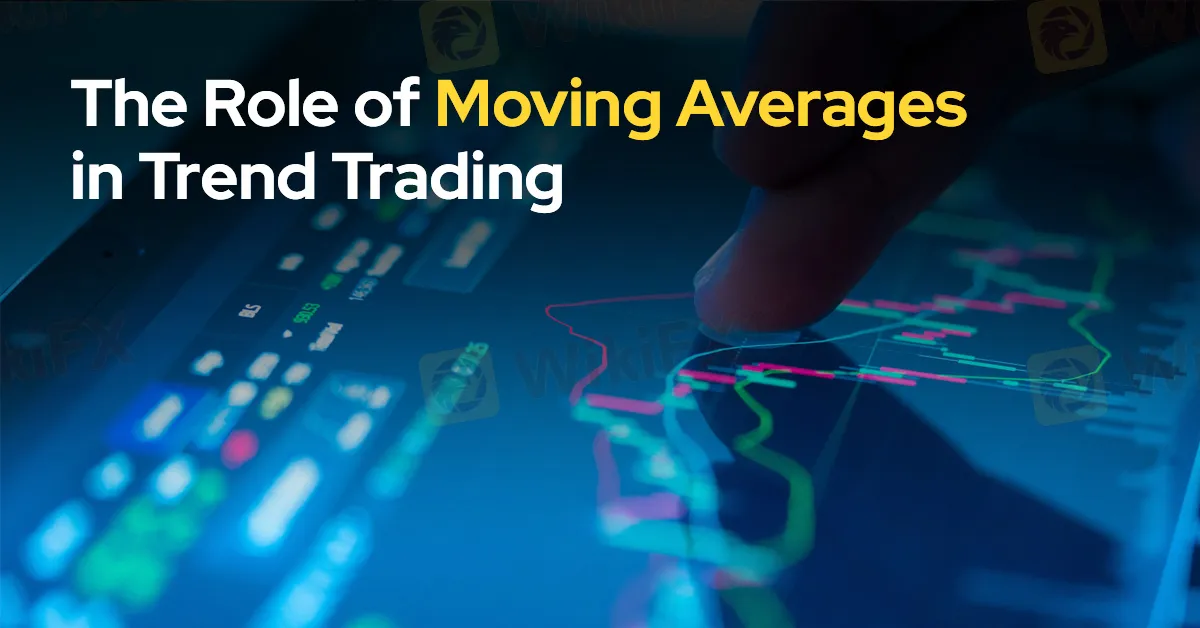简体中文
繁體中文
English
Pусский
日本語
ภาษาไทย
Tiếng Việt
Bahasa Indonesia
Español
हिन्दी
Filippiiniläinen
Français
Deutsch
Português
Türkçe
한국어
العربية
The Role of Moving Averages in Trend Trading
Abstract:Moving averages are essential tools in technical analysis, widely used by traders to identify trends and make informed decisions. By smoothing out price data, moving averages help traders filter out noise and determine the overall direction of a market, making them invaluable in trend trading strategies.

Introduction
Moving averages are essential tools in technical analysis, widely used by traders to identify trends and make informed decisions. By smoothing out price data, moving averages help traders filter out noise and determine the overall direction of a market, making them invaluable in trend trading strategies.
What are Moving Averages?
A moving average (MA) is a statistical calculation that averages a set of data points over a specific period. In trading, the most common types are:
Simple Moving Average (SMA): This is calculated by summing the closing prices over a designated number of periods and dividing by that number. It provides a straightforward average but can lag behind current prices.
Exponential Moving Average (EMA): This gives more weight to recent prices, making it more responsive to new information. EMAs are favored by many traders for their sensitivity to price changes.
Identifying Trends with Moving Averages
Moving averages are primarily used to identify market trends. Heres how they can aid trend trading:
Trend Direction: When prices are above the moving average, it generally indicates an uptrend, while prices below suggest a downtrend. This visual representation helps traders align their positions with the prevailing trend.
Crossovers: One of the most popular strategies involves using two moving averages—a shorter period and a longer period. A bullish crossover occurs when the shorter MA crosses above the longer MA, signaling a potential buy opportunity. Conversely, a bearish crossover happens when the shorter MA crosses below the longer MA, indicating a potential sell signal.
Support and Resistance Levels: Moving averages can act as dynamic support and resistance levels. In an uptrend, the moving average may serve as support, while in a downtrend, it can act as resistance. Traders often look for price action around these averages to make decisions.
Combining Moving Averages with Other Indicators
While moving averages are powerful on their own, they are often more effective when combined with other technical indicators. For example:
Relative Strength Index (RSI): This momentum oscillator can help confirm trends identified by moving averages. A bullish signal is stronger when the RSI is above 50, while a bearish signal is confirmed when its below 50.
MACD (Moving Average Convergence Divergence): This indicator uses moving averages to identify momentum and trend changes. Traders can look for crossovers and divergence between MACD and price action for additional confirmation.
Limitations of Moving Averages
Despite their usefulness, moving averages have some limitations:
Lagging Indicator: Moving averages are lagging indicators, meaning they react to price changes rather than predict them. This delay can result in late entry or exit points.
Whipsaws in Sideways Markets: In choppy or sideways markets, moving averages can produce false signals, leading to potential losses.
Parameter Sensitivity: The effectiveness of moving averages depends on the chosen time period. Shorter periods can generate more signals but may also increase noise, while longer periods smooth out fluctuations but can delay signals.
Conclusion
Moving averages play a crucial role in trend trading, helping traders identify and capitalize on market trends. By providing insights into trend direction, potential entry and exit points, and acting as dynamic support and resistance, moving averages can enhance trading strategies. However, traders should be mindful of their limitations and consider combining them with other indicators to improve overall effectiveness. Understanding how to leverage moving averages can significantly enhance a trader's ability to navigate the ever-changing forex market.

Disclaimer:
The views in this article only represent the author's personal views, and do not constitute investment advice on this platform. This platform does not guarantee the accuracy, completeness and timeliness of the information in the article, and will not be liable for any loss caused by the use of or reliance on the information in the article.
Read more

Webull Launches SMSF Investment Platform with Zero Fees
Webull introduces commission-free SMSF trading, offering over 3,500 US and Australian ETFs, with no brokerage fees and enhanced portfolio tools.

The Ultimate Guide to Automated Forex Trading in 2025
Modern markets are revolutionized by automated trading systems, which now execute 70-85% of all transactions. These advanced automated trading software solutions, commonly called trading robots or Expert Advisors (EAs), leverage algorithmic precision for automatic trading across forex, stocks, and commodities 24/7. By removing emotional interference and executing trades in microseconds, auto forex trading platforms create fair opportunities for all market participants. For those new to automated trading for beginners, these systems provide disciplined, backtested strategies while significantly reducing manual effort.

How Reliable Are AI Forex Trading Signals From Regulated Brokers?
Discover how reliable AI Forex trading signals are and why using a regulated broker boosts their effectiveness. Learn key factors to evaluate accuracy and enhance your trading.

Top Currency Pairs to Watch for Profit This Week - March 31, 2025
Discover the top 5 currency pairs to trade for profit this week, March 31, 2025—USD/JPY, EUR/USD, GBP/USD, AUD/USD, USD/CHF—with simple strategies and best times.
WikiFX Broker
Latest News
How Crypto Trading Transforms FX and CFD Brokerage Industry
FCA Warns Against 10 Unlicensed or Clone Firms
CySEC Warns Against 14 Unlicensed Investment Websites
Top Currency Pairs to Watch for Profit This Week - March 31, 2025
Will natural disasters have an impact on the forex market?
Philippines Deports 29 Indonesians Linked to Online Scam Syndicate in Manila
Exposing the Top 5 Scam Brokers of March 2025: A Closer Look by WikiFX
Gold Prices Climb Again – Have Investors Seized the Opportunity?
Webull Launches SMSF Investment Platform with Zero Fees
Australian Regulator Warns of Money Laundering and Fraud Risks in Crypto ATMs
Currency Calculator







